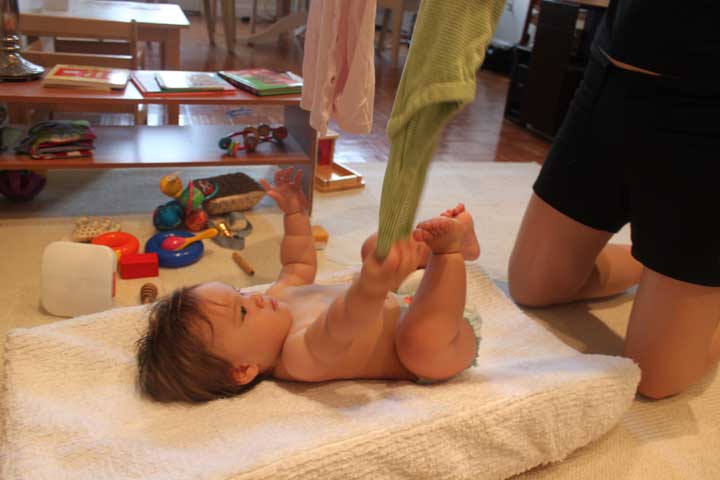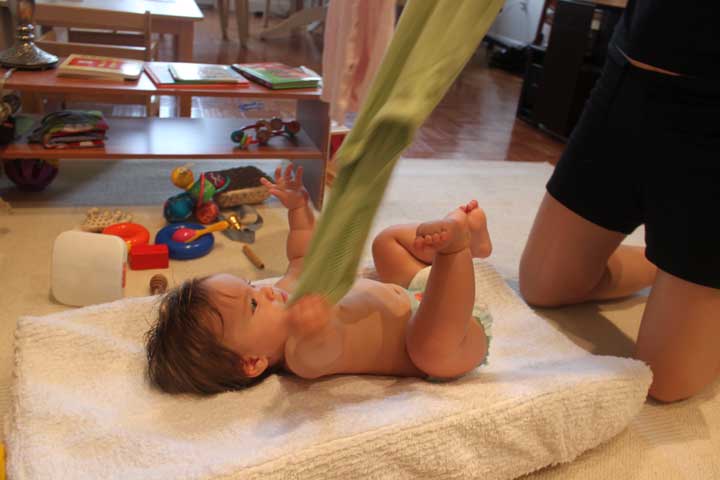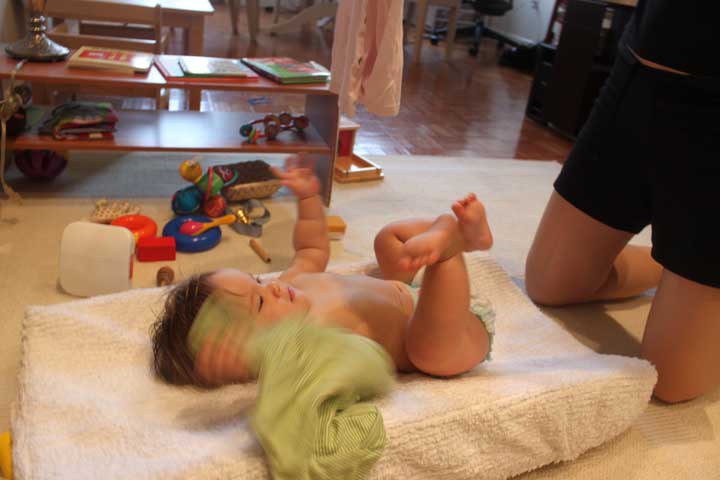让你的宝宝自己选择他要穿的衣服
孩子7到8个月大的时候,就可以让他们自己做选择了哦。不过不要太过火哦!让他们二选一就够了。每次帮孩子们洗澡后,我就会挑两件衣服给他们选。 Mackenzie讨厌粉红色,可是很喜欢绿色。Brooke,她喜欢的是连身衣。她们的选择一概不变,非常肯定自己要的是什么。真了不起!



不顾一切地把青色连体衣从我手中抢过去!要就是要!
孩子7到8个月大的时候,就可以让他们自己做选择了哦。不过不要太过火哦!让他们二选一就够了。每次帮孩子们洗澡后,我就会挑两件衣服给他们选。 Mackenzie讨厌粉红色,可是很喜欢绿色。Brooke,她喜欢的是连身衣。她们的选择一概不变,非常肯定自己要的是什么。真了不起!



不顾一切地把青色连体衣从我手中抢过去!要就是要!
帮孩子选择衣服的时候,要考虑到很多条件。
1. 衣服会怎么影响他们的生理功能?呼吸系统?血液循环系统?消化系统?
衣服的腰部不可以太紧,袖口和苦关口也不可以绑住他们的四肢末端。因爲宝宝的成长非常快,您可能会需要预先准备好一些大小不同的裤子。尿布也不可以贴的太紧,不然会阻挡到中医里所谓的丹田。让他们体内里的气自由流动吧!
2. 衣服会怎么影响他们的移动方式?您看上的那件衣服会让他们方便移动吗?
这一点是关键。千万不可以让宝宝穿牛仔裤或者牛仔夹克!牛仔布料非常僵硬。穿着它们的小孩子是无法行动自如的!
2到3个月以上的宝宝最适合穿棉布连身衣了。除非您得带他们去参加特别的活动,我推荐您95%的时间都让他们穿着全棉的连身衣,尤其是在他们在学习爬和把自己拉直的时候。
3. 周围的气候如何?会不会需要从热天气,冷天气,还是昆虫保护他们的皮肤?
有时候会看到一些亚洲母亲把孩子包到像小粽子一样!这叫他们怎么自由移动嘛?
4. 我们该选用什么样的纤维?衣服的接缝够舒服吗?
羊毛,绒毛,丝绸等动物纤维虽然可以帮宝宝保暖,但是他们比植物纤维难护理得多了。确保所有会触摸到宝宝皮肤的布料都是用植物纤维做的话会比较好。这种天然布料不需要太多的照顾,但是又柔软透气,很适合接触到宝宝的皮肤。您喜欢的话,也可以用未处理的有机棉布。合成纤维(如人造纤维,聚酯纤维,尼龙等)也不错,因爲它们非常容易处理–基本上丢进洗衣机里就行了。不过这些布料并不透气,而且一旦沾上味道或污点,就很难去除。很多年来,因爲方便,家长们喜欢给孩子穿聚酯纤维制的衣服。不过现在,我们开始了解其实合成纤维对宝宝并不是很好。如果您比较关心金钱的方面,您可以考虑给孩子穿植物纤维的内衣和合成纤维的外套。总之,只要布料会碰到宝宝的皮肤,请慎重考虑使用植物纤维制的衣裳。
5. 顔色呢?
染色剂里通常有很多糟糕的东西,所以给刚出生宝宝穿的衣服应该是天然白色或浅色。
6. 款式呢?
买连身衣的时候,要看看宝宝的身体合不合身。宝宝身体的长短会有不同的衣着需要。
虽然Brooke才8个月大,她已经在穿18到24个月大宝宝的衣服了。袖口和裤管口都有点太大,不过身体长度刚刚好,所以爲了让她感到舒适,我们就选择给她穿这些比较大一点的衣服。
7. 每个年龄段应该买多少件衣服?
稍后会详细讨论。简单来説,如果您有双胞胎的话,请做好心理准备买很多很多的衣服哦!
8. 衣服会容易照顾吗?
买之前问问自己:这布料会缩水吗?钮扣会紧吗?容易掉吗?
宝宝的衣服和大人的衣服一定要分开洗。如果您用的是布尿布,尿布和宝宝的衣服也要分开洗。我建议您使用一些不含香料,染色等的婴儿洗涤剂来洗宝宝的衣服。